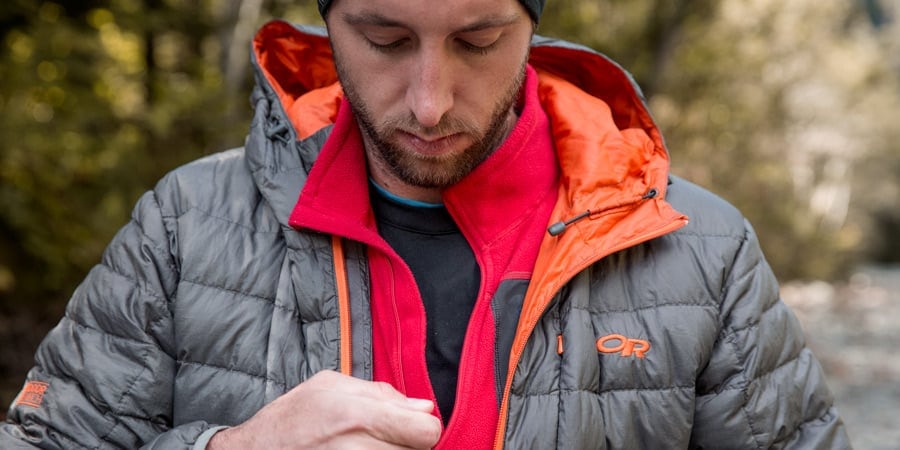When hiking, it’s important to wear layered clothing. Layering your clothing helps you regulate your body temperature, which is important when you’re exerting yourself and might get overheated. It also helps protect you from the elements, like wind and rain.
And if you happen to get wet, layering can help you stay warm until you can dry off.
Most hikers wear layered clothing because it helps regulate their body temperature. By wearing multiple layers, hikers can add or remove clothing as necessary to stay comfortable.
Layered clothing also provides protection from the elements.
Wearing a waterproof outer layer can help keep hikers dry in wet conditions. And, layering can provide extra warmth in cold weather.
There are other reasons why some hikers prefer layered clothing over a single piece of gear.
Layered clothing is usually lighter and more compact than a single item, making it easier to pack for a hike. And, if one layer gets damaged or dirty, hikers can simply take it off and put on a fresh one.
Whether you’re just starting out or are an experienced hiker, give layered clothing a try on your next adventure.
You might be surprised at how well it works!
What to Wear Hiking in Any Weather! | Miranda in the Wild
What is the Purpose of Layering Clothes?
There are many reasons why people layer their clothes. Some do it for practical reasons, to keep warm or to protect themselves from the sun. Others do it for aesthetic reasons, to create a certain look or to make a fashion statement.
Whatever the reason, layering can be a great way to add interest and variety to your wardrobe.
Practical Layering
One of the most common reasons for layering is to keep warm in cold weather.
Wearing multiple layers of clothing traps heat between them, creating a barrier against the cold air outside. This is why people often layer heavier items like jackets and sweaters on top of lighter items like shirts and t-shirts.
You can also use layering to protect yourself from the sun.
Wearing loose, lightweight layers helps prevent sunburn by allowing heat and light to escape before they can damage your skin. This type of layering is especially popular in hot climates where the sun is intense but the air temperature may be cool enough that you don’t want to wear shorts or a tank top.
Aesthetic Layering
Layering can also be used purely for aesthetic purposes. Wearing multiple layers of clothing can create a certain look or feel that you might be going for. For example, pairing a flowing dress with a jacket and scarf creates a more formal look than wearing the dress alone would.
Or, if you’re going for a bohemian vibe, layering different textures and patterns can give your outfit an eclectic feel.
What is Layering in Hiking?
When it comes to layering for hiking, there is no one-size-fits-all answer. The amount and type of clothing you’ll need will vary depending on the weather conditions, the terrain and your own personal preferences. But in general, it’s a good idea to layer your clothing so that you can easily add or remove layers as needed.
The first layer should be a base layer made of synthetic material or wool. This layer will help wick away sweat and keep you warm even when wet. The second layer should be an insulating layer such as fleece or down.
This layer will provide warmth even when dry and help protect you from the wind. The third layer is your outer shell, which should be waterproof and breathable to protect you from the elements.
Of course, you’ll also need to pack some essential items like extra socks, a hat, gloves and a map.
And make sure to drink plenty of water throughout your hike to stay hydrated. By following these simple tips, you’ll be prepared for any adventure that comes your way.
What is the Best Outfit to Wear When Hiking?
Assuming you want tips on what to wear hiking:
The best outfit to wear when hiking really depends on the weather and terrain. However, there are some general guidelines that can be followed.
For example, if it is hot outside, it is important to wear light-colored and loose-fitting clothing. This will help keep you cool and prevent you from getting overheated. Wearing a hat or visor is also a good idea to protect your face from the sun.
If it is cold outside, it is important to dress in layers. Wear a base layer made of synthetic material (such as polyester) next to your skin to wick away sweat. Add an insulating layer on top of that (such as fleece) and then a waterproof outer layer (such as Gore-Tex).
This will help keep you warm and dry no matter what the weather throws at you.
In terms of footwear, make sure to choose shoes or boots that are comfortable and provide good support. It is also important to break them in before hitting the trail so you don’t end up with blisters.
If you will be hiking through water, make sure to choose shoes or boots that can get wet without causing discomfort.
Finally, make sure to pack plenty of water and snacks so you stay hydrated and fueled during your hike!
Why is Clothing Important in Hiking?
Assuming you are referring to why clothing is important for hikers, there are several reasons.
For one, clothing protects against the elements. Hikers need to be prepared for all types of weather conditions, whether it be extremely hot or cold, wet or dry.
The right clothing will help regulate their body temperature and keep them comfortable during their hike.
Clothing also needs to be durable in order to stand up to the rigours of hiking. Clothing that tears easily or doesn’t provide enough support can ruin a hike very quickly.
Finally, clothes need to be functional. They should allow hikers to move freely and not get in the way of their hiking experience.

Credit: www.rei.com
Base Layer Hiking
Assuming you would like a blog post discussing the benefits of base layer hiking clothing:
When it comes to enjoying the great outdoors, comfort is key. And when it comes to staying comfortable on a hike, your base layer plays a vital role.
A good base layer will wick away sweat and moisture, regulate your body temperature, and provide much-needed support and compression. In other words, a good base layer can make or break your hike (literally).
With that in mind, let’s take a closer look at what makes for a great hiking base layer and some of the best options on the market today.
What to Look for in a Base Layer for Hiking?
There are three main things you want to look for in a base layer for hiking: wicking ability, warmth, and breathability. Let’s break each one down:
Wicking Ability: First and foremost, your base layer needs to be able to wick away sweat and moisture. When you’re out on the trail, you’re bound to work up a sweat – even in cooler weather. And if your sweat isn’t being effectively wicked away from your skin, it can lead to chafing, blisters, and all sorts of other uncomfortable issues.
So make sure your chosen fabric has excellent wicking ability. Merino wool is always a good bet here as it naturally pulls moisture away from the skin without absorbing it (unlike cotton).
Warmth: Depending on what time of year you plan on doing most of your hiking (and where), you may need more or less warmth from your base layer.
If you tend to hike in cold weather or at high altitudes where temperatures can drop quickly, then opt for something thicker with more insulation like merino wool or synthetic fleece. For moderate conditions or warmer climates however ,a thinner merino wool or synthetic fabric will do just fine .
Breathability: In addition to being able to wick away sweat ,your hiking base layer also needs to be breathable .
This is especially important if you tend to hike in hot weather as you don’t want your clothing trapping all that heat against your skin . Again ,merino wool is usually a good option as it’s quite breathable while still providing adequate warmth . However ,synthetic fabrics such as polyester are often even more breathable while still offering decent moisture-wicking capabilities .
What is the Correct Order of the Three-Layer Clothing Principle in Hiking?
When it comes to layering clothing for hiking, there is a general rule of thumb that is followed in order to ensure maximum comfort and protection from the elements. This rule is known as the three-layer clothing principle. Here’s a breakdown of what each layer should entail:
The first layer, also known as the base layer, should be made up of moisture-wicking material such as synthetic fabrics or wool. This layer’s main purpose is to keep you dry by wicking away sweat and moisture from your skin.
The second layer, also known as the insulating layer, provides warmth by trapping heat close to your body.
Common materials used for this layer include down or synthetic insulation.
The third and final layer, also known as the shell layer, protects you from the elements such as wind and rain. This layer is typically made up of waterproof and breathable fabric such as Gore-Tex.
Base Layer Clothing for Cold Weather
Assuming you would like a blog post discussing the best base layer clothing to wear for cold weather:
When layering clothes to keep warm in cold weather, it is important to start with a good base layer. Base layers are the foundation of your cold-weather wardrobe and provide a thin layer of insulation next to your skin.
They are typically made from synthetic fabrics that wick away moisture and help regulate body temperature.
There are many different types of base layer clothing available, so it is important to choose one that will work well for the activity you have planned. For example, if you’re going for a hike, you’ll want something lightweight and breathable.
If you’re going to be out in the snow all day, you’ll want something thicker and warmer.
Some of the best materials for base layers include merino wool, polyester, and nylon. These materials are all effective at wicking away moisture and keeping you comfortable in cold weather.
When choosing a base layer garment, look for one that fits snugly but is not too tight. It should also be comfortable against your skin – avoid anything scratchy or itchy.
Once you have a good base layer sorted, the rest of your cold-weather outfit will fall into place more easily.
With a warm foundation in place, you can then add additional layers as needed depending on the temperature outside and your level of activity.
Conclusion
When hiking, it’s important to wear layered clothing. This is because the weather can change quickly and you need to be prepared for both warm and cold temperatures. Wearing layers also allows you to regulate your body temperature better.
When you get too hot, you can take a layer off. And if you get too cold, you can put a layer on.
